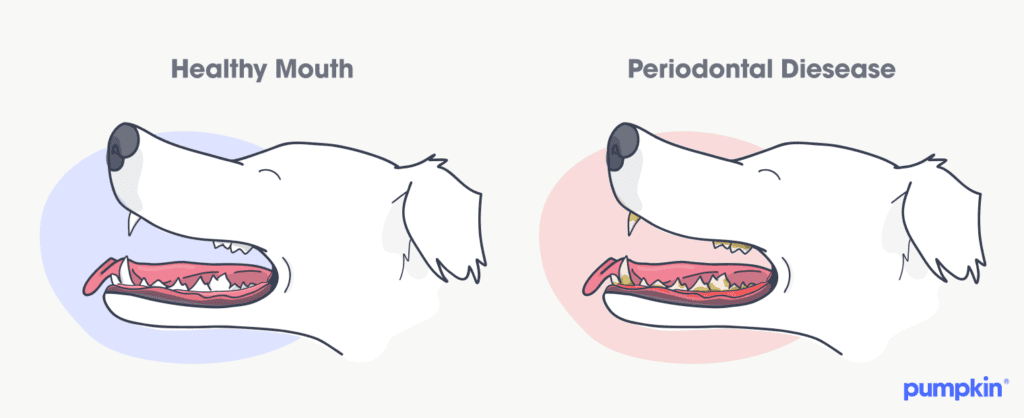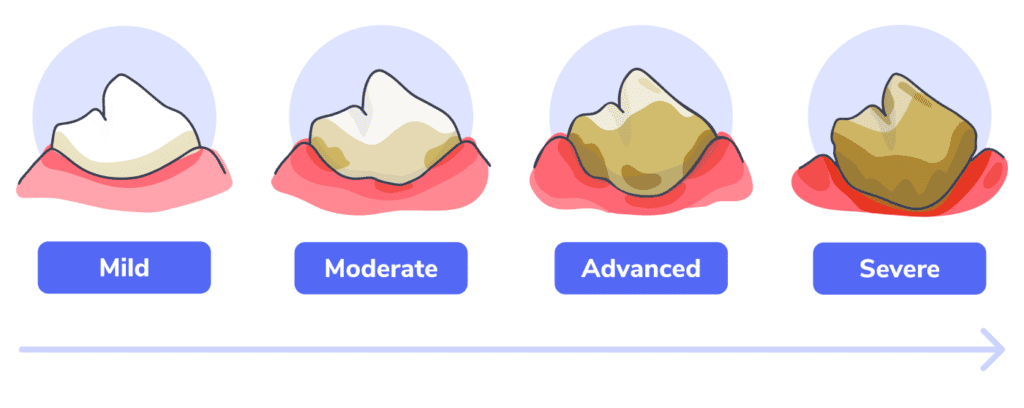Why Is Dog Dental Care Important?
Did you know that taking care of your pup’s pearly whites is just as important as taking care of your own? With 80% of dogs over age three showing some sign of dental disease, regular dental health care is essential to help keep your dog’s teeth and gums healthy throughout their life.
Poor dental health can also lead to a host of other problems for your dog. Dental disease can cause dangerous infections that spread to major organs, like the heart, lungs, liver, and kidneys.
“Good dental health is the foundation for good overall health. Chronic bacteria in periodontal disease will not only cause discomfort in the mouth but also have the potential to spread to vital organs like the kidneys, liver, and heart.“
Dr. Patricia Collins, DVM
How does dental disease develop?
Doggy teeth go through a lot every day, from breaking down food to carrying toys to self-grooming. The combination of saliva, food, and bacteria creates plaque, a sticky substance that adheres to the tooth surface, and calcifies into tartar. If your pet’s teeth aren’t cleaned and maintained properly, plaque and tartar can build up, which can cause:
- Bleeding, inflamed gums (gingivitis)
- Periodontal (gum) disease
- Painful infections and/or abscesses
- Bad breath
- Tooth decay
- Tooth loss
Periodontal disease – big ruh-roh!
You’ll hear periodontal disease, or gum disease, often talked about in dog dental health. It’s an infection of the tissue around the teeth and can cause bone and tooth loss in the advanced stages. You may not think it, but it’s one of the most common diseases affecting both dogs and cats!
Here you can see what a healthy mouth looks like vs a mouth with periodontal disease.

Advanced periodontal disease often affects your dog’s health beyond their mouth. The harmful bacteria produced in your dog’s mouth enters the bloodstream and can gradually damage the heart, kidneys, and liver. This is why regular dental care is crucial for your pup’s overall health and wellbeing as well. This is especially true for small and toy breeds – they have tiny mouths, which makes them more susceptible to dental disease.
“Dental disease has a significant impact on our pets’ overall health. Periodontal disease puts our pets in a state of chronic inflammation and constantly swallowing bacteria can have effects on the liver, kidneys, and heart.“
Dr. Mondrian Contreras, DVM
The good news is a consistent dental routine can decrease your pup’s chances of developing dental issues. And if you know what signs to look for, you can catch dental problems early enough to treat them.
As with any serious health condition, the costs of treating dental disease can add up quicker than you might think. If your pup does develop dental disease, it’s priceless to know you have help getting them the treatment they need. With a pet insurance plan that covers dental illnesses – like a Pumpkin Pet Insurance plan – you can have peace of mind knowing you have help affording your pup’s covered veterinary bills.
Top 4 Ways to Help Prevent Dental Disease

1. Regular Professional Dental Checkups and Cleanings
Getting regular dental checkups is crucial for preventing dental disease and catching the early signs. For tip-top oral health, your dog should have a professional dental checkup and cleaning every 12-24 months, depending on your veterinarian’s recommendation and your dog’s needs.
For the checkup, the veterinarian will conduct a full oral exam, including measuring periodontal pockets around the teeth with a blunt probe and taking x-rays. They will look for:
- Any missing or extra teeth, an overbite, or an under-bite
- Fractured or broken teeth
- Presence of gingivitis or periodontal disease
- Buildup of tartar on teeth and along the gumline
- Abscesses or signs of infection
- Bumps or lesions that may indicate a tumor
- Any facial swelling
During the cleaning, your veterinarian will:
- Polish your dog’s teeth to smooth out the surface and make it harder for plaque to stick
- Flush your dog’s mouth to remove any remaining bits of plaque or tartar
- Make any recommendations for ongoing oral care
For a dental cleaning and checkup, the veterinarian will put your pup under anesthesia to keep them still and safe. This allows your dog to rest pain-free while the veterinarian does all the necessary checks and cleaning. To make sure general anesthesia is safe for your dog, your veterinarian will conduct a thorough pre-anesthesia evaluation and monitor your dog’s vital signs throughout the procedure.
This step is important because often your veterinarian can’t know the extent of dental disease until your dog is under anesthesia and they perform a complete dental exam, including x-rays.
“There can be many reasons a pet parent is reluctant to get a cleaning, like previous anesthesia experience, discomfort, scared of being separated from their pet for the day etc. but the two most common reasons I find that people are reluctant to do regular cleanings are: 1. they think that dental disease is normal (so they don’t think it’s necessary to have them cleaned) and 2. anesthesia concerns. The anesthesia concern is usually addressed by helping pet parents understand that blood work is required before the procedure to make sure overall health is good and we have all the monitoring equipment to make sure ALL our vital and things like EKG, Blood Pressure, SPO2, EtCO2 are all monitored throughout the procedure.“
Dr. Mondrian Contreras, DVM
Now’s a great time to schedule your annual dental cleaning with your veterinarian! They can help you maintain your dog’s dental hygiene.

2. Brushing Your Dog’s Teeth at Home
Daily tooth brushing is one of the most effective ways dog owners can help prevent dental issues. Even though dental disease is common and affects a majority of dogs, only 8% of dog parents brush their dog’s teeth daily!
Brushing those canine teeth daily is a great way to help prevent the buildup of plaque, which is a yellow-colored bacteria film. Regular brushing gently removes that leftover gunk that can calcify into tartar. This is key as once tartar forms, it can only be removed by a veterinarian.
Coaxing your dog into teeth cleaning may be challenging (especially if they’re not used to it), but it’s worth getting right. Here’s some advice to help you get those teeth clean.
“Daily dental routines should be established as soon as your puppy comes home. Pet owners should start getting used to looking in the mouth, handling the face, and gently putting fingers in the puppy’s mouth. As part of my first meeting with a puppy, I will discuss future dental care and its importance with the owners. Puppies have baby teeth, but just like with human babies, it is important to establish routines as early as possible.“
Dr. Patricia Collins, DVM
How to brush your dog’s teeth
Step 1 – Start early and gradually
The sooner you can start brushing your pet’s teeth, the better. The key is getting your pup used to you touching their mouth inside and out. Run your fingers over the outside of their mouths, chin, and cheeks. The whisker area may be sensitive, so go slow. After your dog is comfortable with this, run your finger around the inside of their mouth, and over the gums. Make sure to give them praise as you go!
Step 2 – Make teeth cleaning tasty
Next, put a dab of dog toothpaste on your finger and let your dog taste it. Dog toothpaste comes in many flavors such as chicken, liver, or peanut butter, and your pup will like the taste. Never use human toothpaste as fluoride will upset your dog’s digestive system, and is toxic when swallowed.
Step 3 – Introduce the toothbrush
Now you can introduce your pup to a doggy toothbrush. Start by letting them mouth and play with it. When they’re comfortable, add toothpaste and let them lick it off. If that goes well, gently brush the outside of your dog’s teeth and gums using slow, circular motions. You’ll want to angle the brush bristles up toward the gum line to clean it. Start with a few teeth at a time, before progressing to the whole mouth and the inside of the teeth. If your dog just isn’t having it, you can use cotton gauze wrapped around your finger, a dental wipe, or a finger brush.
Step 4 – Keep it brief and fun
You only need a couple of minutes each day to achieve good oral hygiene. Keep teeth cleanings quick, and use praise throughout to make the sessions a positive experience. Make sure to reward your pup with healthy treats and give them lots of love afterward!
If you’d like to see this in practice, watch this helpful video.
“Nothing takes the place of brushing, I always make sure owners know that, then I direct them to the Veterinary Oral Health Council website for veterinary dentist-approved products for their pets, and make sure that they use approved products while also ALWAYS BRUSHING their pet’s teeth.“
Dr Mondrian Contreras, DVM
3. A Balanced, Healthy Diet
A balanced diet plays a key role in healthy teeth and gums and boosts your pup’s overall health. Many pet parents believe that kibble will clean their dog’s teeth, however, it’s only helpful to the point that kibble/crunchy food provides friction to the surface of the tooth enamel. It cannot remove plaque or tartar, especially not at the gumline, which is the most important zone.
In addition to a healthy diet, you may consider giving your pup enzymatic rinses and water additives. These can help prevent the formation of plaque on your dog’s teeth by raising the pH balance in your dog’s mouth and demineralizing the plaque. They can be sprinkled on top of dog food, or added to your dog’s water bowl.
4. Dental Chews and Dental Friendly Toys or Treats
Dental-friendly toys and treats are beneficial as teeth-cleaning tools. As your dog chews them, they scrape the plaque off the tooth and massage the gums to improve your dog’s oral health. If you’re not sure what to get, you can safely give your dog any product approved by the Veterinary Oral Health Council.
Here are some examples of products you can give your pup:
- Kongs
- Nylabones
- Dental chewable treats
Chewing is very important for all dogs – it can help them relieve stress, provide mental stimulation, and keep their teeth healthy. However, it can cause harm if they’re gnawing on the wrong stuff.
Always avoid giving your pup:
- Any bones or chew sticks that can fracture teeth
- Anything that can splinter and leave sharp edges that can cut your dog’s gums, tongue, or be swallowed and create havoc in their gastrointestinal system
- Tennis balls – while they’re okay for fetch, they are not good chew toys
How to Spot the Signs of Dental Disease

If your dog yawns and you get a whiff of stinky breath, it might mean they’re having dental problems! Knowing what to look out for is key in recognizing and seeking treatment for doggy dental disease, and we’re here to help.
These signs are clear indicators that something is up with your pup’s chompers:
- Unusually smelly breath
- Facial swelling
- Pain around or inside the mouth
- Bloody or swollen mouth or gums
- Broken or discolored teeth
- Visible tartar buildup on the teeth and gum line
- Abnormal chewing
- Drooling (sometimes bloody) or dropping food from mouth
- Sneezing or nasal discharge (dental disease on upper teeth can destroy the bone and invade the nasal cavity)
- Decreased appetite or refusal to eat
Remember, even though you should always do your own checks, nothing can replace a dental exam by your veterinarian.
“In terms of the differences between pets who have had a good dental routine early in life compared to those who haven’t, the difference is typically dramatic because those pets do not have to deal with oral pain (gingivitis) and their breath smells great. Most pets with early intervention keep all their teeth throughout their life thus not having to endure periodontal disease – like tooth decay, inflamed gums, and tooth loss. All of which can affect our pet’s quality of life.“
Dr. Mondrian Contreras, DVM
How Dental Disease is Treated
If your own checks or your veterinarian’s exam reveals signs of dental disease, the treatment will depend on how advanced the disease is.

| Level | Description | Treatment |
| Mild | There’s a buildup of plaque and tartar on the tooth, red gums, but no bone loss. | A professional cleaning and ongoing daily brushing can treat this. |
| Moderate | There’s a buildup of plaque and tartar on the tooth, red gums, and some mild bone loss. | A professional cleaning and ongoing daily brushing will be necessary so there is no further bone loss. |
| Advanced | There’s a buildup of plaque and tartar on the tooth and below the gumline, inflamed gums, and significant bone loss. | A professional cleaning and ongoing daily brushing will be necessary so there is no further bone loss, and extraction will be required for teeth with too much bone loss. |
| Severe | Over 50% of the bone has been lost, the gums are infected, and in the most severe cases, the infection has spread to the bloodstream. | Damaged teeth will need to be extracted, and the gums will need to be surgically closed with sutures. If an infection is present, antibiotics are typically prescribed. Dogs will also need soft food and pain management after dental treatments. |
“I see periodontal disease in dogs on a daily basis. If the teeth are not getting brushed daily or at least every other day the chance of them developing dental disease by age 3-4 is extremely high. The gold standard of treatment is dental cleaning with assessment of dental pockets in the gums and survey radiographs of the teeth. Followed up by daily routines at home, like brushing, dental wipes, and dental rinses.“
Dr. Patricia Collins, DVM
If your dog needs oral surgery, a Veterinary Dental Specialist may be called in for more involved procedures such as removing tumors, excising gums with severe periodontal disease, root canals, or tooth extractions for damaged or impacted teeth. These procedures may sound scary, but your dog will quickly get back to their normal self.
Final Thoughts
Any degree of dental disease can be rough for your pup. It’s vitally important to maintain a consistent routine, to have regular professional cleanings, and to provide the right diet so your dog can live a longer, healthier life.
The next time you see your veterinarian, ask their advice for the best dental care for your dog and if they recommend any specific preventative measures. Your pup (and all 42 of their teeth) will thank you for it!
If your dog develops dental disease, it pays to have pet insurance to help you cover the costs of the treatment they may need. With a Pumpkin plan, 90% cash back on eligible vet bills is always an option, making it easier to say ‘yes’ to the best dental care for your pup.
Please note: The information presented in this article is for educational and informational purposes only and does not constitute or substitute for the advice of your veterinarian.




